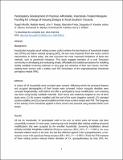| dc.description.abstract | Background
Insecticidal mosquito-proof netting screens could combine the best features of insecticide treated nets (ITNs) and indoor residual spraying (IRS), the two most important front line vector control interventions in Africa today, and also overcome the most important limitations of these two methods, such as pyrethroid resistance. This study engaged members of a rural Tanzanian community in developing and evaluating simple, affordable and scalable procedures for installing readily available screening materials on eave gaps and windows of their own houses, and then treating those screens with a widely used IRS formulation of the organophosphate insecticide pirimiphos-methyl (PM).
Methods
A cohort of 54 households were recruited upon consent, following which the structural features and occupant demographics of their houses were surveyed. Indoor mosquito densities were surveyed longitudinally, both before and after a participatory house modification, and screening was done using locally available materials. Each house was randomly assigned to one of three study arms: (1) No screens installed until the end of the study (negative control), (2) untreated screens installed, and (3) screened installed and then those screens treated with PM. The longevity of the activity of the insecticide applied to these screens was assessed using standard WHO cone assays.
Results
Of the 54 households, 52 participated until to the end, at which point all houses had been successfully screened. In most cases, screening was only installed after making enabling structural modifications that were accepted by the enrolled households. Screening installations almost entirely excluded Anopheles arabiensis (Relative reduction (RR) ≥ 96%, P < < 0.0001), the most abundant malaria vector in the area; but was less effective against Culex quinquefasciatus, a non-malaria vector with significant biting nuisance (RR ≤ 46%, P < < 0.0001). While the PM treatment of these netting screens reduced indoor densities of Cx. quinquefasciatus by only 24%, An. arabiensis was reduced by 63% and treated screens exhibited satisfactory residual efficacy eight months after treatment.
Conclusions
This study demonstrates that participatory approaches to mosquito proofing houses may be acceptable and effective, and that installed screens may be suitable targets for treatment with residual insecticides. | en_US |

